Podcast: Play in new window | Download | Embed
Subscribe: Apple Podcasts | RSS
Podcast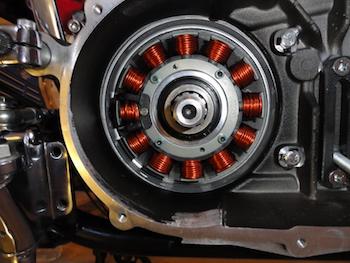 -A special thanks to guest Evan Grist of Fort Collins, Colorado, who is an electrical engineer and affiliated with RMSTATOR, a manufacturer of high-end power sports electrical parts. Via Skype, we were able to bounce our questions off Evan. In this episode, we'll teach you everything you need to know about your Harley-Davidson charging system. We break it down to what bikers actually need to know in an understandable way.
-A special thanks to guest Evan Grist of Fort Collins, Colorado, who is an electrical engineer and affiliated with RMSTATOR, a manufacturer of high-end power sports electrical parts. Via Skype, we were able to bounce our questions off Evan. In this episode, we'll teach you everything you need to know about your Harley-Davidson charging system. We break it down to what bikers actually need to know in an understandable way.
Your Harley-Davidson, or most motorcycles for that matter, use the same type of charging system, often referred to as a permanent magnet alternator. In a car, an alternator is belt driven. In a motorcycle, it is driven by magnets embedded around the flywheel. The flywheel is permanently affixed to the crankshaft, which is spinning with the engine RPM's.
 Check out the Official Law Abiding Biker Store!
Check out the Official Law Abiding Biker Store!
So, the easy way to generate power is with a stator inside that flywheel magnet system. A stator is a metal core and is made up of a bunch of stamped steel plates that are riveted together. It's insulated with some sort of powder coat or plastic to protect the wires. There are windings wrapped around it, which are a particular gauge of solid core copper wire that's insulated. So, you end up with coils of wire wrapped around the stator. Those are attached to a wiring harness, which exits the side case of the motor & heads to the regulator/rectifier. And finally, to the battery to charge it.
With the motor running, you have your crankshaft spinning with the flywheel attached to the end with the magnets spinning outside of the stator. Those magnets spinning past and around the  metal core with wire wrapped around it generates electricity. And there you have it!
metal core with wire wrapped around it generates electricity. And there you have it!
CHECK OUT OUR AWESOME BIKER TUTORIAL VIDEOS
You may hear this referred to as an alternator at times. If you hear someone call this an alternator on a motorcycle, they are generally referring to the entire package, the flywheel and stator. You do see Harley-Davidson refer to it as an alternator in their manuals.
Regulator/Rectifier:
The alternate current (AC) current created by the stator cannot be sent directly to the battery. It needs to be prepared, limited, and changed to direct current (DC) to correctly charge your battery. The current would destroy your battery if not first sent to the regulator/rectifier.
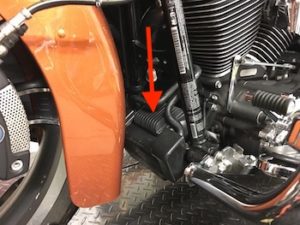 In a motorcycle, the stator flywheel set up creates electricity and sends it to a separate regulator/rectifier. In a car, the rectifier/regulator is built into the alternator.
In a motorcycle, the stator flywheel set up creates electricity and sends it to a separate regulator/rectifier. In a car, the rectifier/regulator is built into the alternator.
On a Harley-Davidson, you'll recognize the separate regulator/rectifier as a little black box with cooling fins machined into it and it often times sits up front behind the rear tire attached to the frame.
Regulator/Rectifier=2 Functions:
Rectifier:
The rectifier is responsible for converting the alternate current (AC) current created by the stator to direct current (DC). Basically, it chops off the negative polarity portion of the current that the battery can't use. Then it passes the current to the battery.
Regulator:
The regulator protects the battery voltage and when the battery voltage climbs too high it shuts off current to ground and bleeds it off as heat. That is what the heat fins on the regulator box are for, 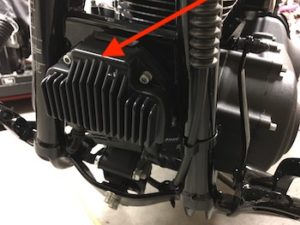 to dissipate the heat. If the regulator did not monitor the voltage to your battery it would destroy it.
to dissipate the heat. If the regulator did not monitor the voltage to your battery it would destroy it.
Note: Often times a bad regulator can do just that, send too much voltage to the battery.
Battery:
All the current required to run your motorcycle comes from your battery. The stator system charges your battery and replenishes it. You could actually run your motorcycle just fine for some time without a working stator as the battery has reserve current. Of course, the battery would eventually die.
CHECK OUT OUR AWESOME BIKER TV CHANNEL
Aftermarket High Output Stators:
If you add too many electrical accessories then you'll come a point that your stator just can't produce enough current to keep the battery charged. There may be subtle hints over time-like your bike starter is sluggish and has trouble cranking the motor over.
There are available aftermarket high output stators. However, it is not wise to install an aftermarket high output stator just because. You should only do this if you actually need it to keep your battery charged.
If your motorcycle is not consuming all that extra current the high output stator is producing then you end up dumping that entire load on your regulator. This is a quick way to ruin your regulator by overheating it.
Can I test the load my electrical accessories are creating?
You can look in your service manual and see what your stator is rated for in amps. Then you can find your electrical accessories (lights, heated grips, heated seats, stereo amps etc) you have added and find out what wattage they are rated for.
A good rule of thumb is you can convert to power by multiplying the stator amps (current) x the battery (voltage). You can use 13 as a good all around battery voltage. That is a good healthy battery staying charged just above 12 volts.
Example only: Let's say the stator is rated for 10 amps x 13-volt battery: 10 x 13=130 watt charging system. So you have a 130-watt charging system in this example.
Now, you can take the wattage of all those electrical accessories and see if you're under or over your 130 watts and how much you have to play with.
Volt Meters:
You can check your system by putting a volt meter on your battery. Or add a volt meter gauge to your motorcycle. I have a Vance & Hines Fuelpak 3 Electronic Fuel Injection (EFI) tuner on my Harley. It syncs to my smartphone wirelessly via Bluetooth and I can monitor real-time data such as voltage. My smartphone is attached to my handlebars with my Biker Gripper Mount.
You can turn all your electrical accessories on and make sure you have your engine at a good regular riding RPM, so your stator is charging at full output.
Note: if your meter is reading anywhere at or above 13 volts you are in great shape. Remember, your Harley is a 12-volt system, so just above that means it can keep up. 13 volts is the point where the battery is not discharging with all your accessories on.
Regulation Point:
Generally speaking, 14.6 volts is a hard set regulation point on most 12 volt systems such as a Harley. Basically, this does not allow the regulator to send voltage to the battery any higher than 14.6 volts.
Harley Charging System Failures:
Stator Failure:
If the stator fails, your battery will no longer be charging when you're riding your motorcycle.
Often times, a short can happen in the windings around the stator. The insulation on the wires can wear down over time or a wire can break. If the copper inside the insulation rubs against the flywheel as an example, you could have the windings short to ground. This is a problem because it all loops back to the regulator through your battery negative connection.
The motor, the frame, and everything metal on the motorcycle are tied to battery negative. Battery negative is tied to the regulator and the regulator is tied to the stator and it loops back. If you have a short to ground then you have no output from the stator.
Multi-Meter & Testing Stator:
Recommended Multi-Meter Tester Here 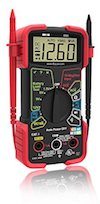 (affiliate link)
(affiliate link)
Find where your 3 stator wires are. On a Harley, this is up front near where the inner primary connects to the motor case. Right by the seam. The three wires will track straight from there to your regulator/rectifier. 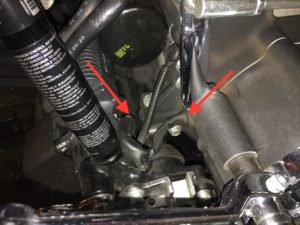
You'll want to measure the resistance between each pair of those wires. The rule of thumb is to look for a low number, around 0.7 Ohms due the size of wire used for this application. You can really measure anywhere under an Ohm. The main thing you want to see is that you are getting the same number between the three wires.
Test 1:
Set your multi-meter to the lowest resistance range it has. Take the three measurements. If they are all the same then your stator windings are in tact and all three coils are in good shape.
Test 2:
Measure from each of those three stator wires to a good frame ground, such as a good clean motor mount bolt, battery negative terminal, or whatever you have that is good and clean and connected to the metal of the motor. Using this test, you should see an “open”. You should see an infinite resistance, no connection, no short from any winding to ground.
**If you pass both these tests you can be 99% certain your stator is good.
Regulator/Rectifier Failure:
Here is a technical document Evan Grist wrote on testing a rectifier.
Multi-Meter Regulator Testing:
Assuming your rectifier part of the unit is still working, you'll see current flowing to your battery. You will see your battery voltage increasing because it has current flowing into it.
If you suspect the regulator part of the unit is not working, you can set your multi-meter to the “DC Volts” setting, generally a 20-volt setting. Then connect it to your battery, start your motorcycle, and rev it up. Ideally, if the regulator is working fine you'll see the battery voltage increase from around 12.8-13.2 volts at idle and increase when the motor is revved up to around 14.6 volts.
**If you see results above 15 volts then you likely have a bad regulator. If you were to ride with 15 volts going to the battery then it will be destroyed.
RMSTATOR MOSFET Regulator/Rectifier Upgrade Kits for Harley:
The standard Harley regulator uses an electrical component in it called an SCR, silicon controlled rectifier, which is a little electrical switch. When the regulator sees your voltage climbing to high to the battery it shorts the stator wires to ground, which kills all the output from that leg of the stator.
The regulators that use the silicon controlled switches are just not very efficient. The electrical switches do not shut on and off quickly and they get very hot. That heat over time can cause regulator failure.
A MOSFET, Metal Oxide Semi Conductor Field Effect Transistor, regulator is a very nice upgrade. This transistor runs much cooler, switches much quicker, has simpler circuitry to control it, which in turn means a longer life.
Additionally, your battery will be much happier as it is much more efficient. When the MOSFET switches current on and off to the battery it is much more efficient, so you end up with much more stable battery voltage. You will see much less voltage fluctuation at the battery, which increases battery life.
-
Use coupon code EGPOD10 for 10% off anything on the RMSTATOR website!
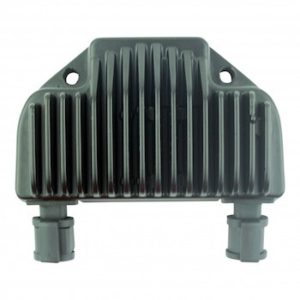 So, you get a longer regulator and battery life! Evan Grist recommends the following regulator/rectifier kit for your Harley-Davidson electrical system.
So, you get a longer regulator and battery life! Evan Grist recommends the following regulator/rectifier kit for your Harley-Davidson electrical system.
- Universal Mosfet Harley Voltage Regulator Rectifier from RMSTATOR
- Harley-Davidson Specific Regulator Rectifier from RMSTATOR
If you upgrade your stator, you'll definitely want to upgrade your regulator/rectifier as it may be working harder regulating the additional current.
These notes are for reference and you'll want to listen into this episode to get even further details!
New Patrons:
- Michael Quade of Mechanicsville, MARYLAND
- Christopher Chandler
- Paul Wear of Fremont, CA
If you appreciate the content we put out and want to make sure it keeps on coming your way then become a Patron too! There are benefits and there is no risk.
Thanks to the following bikers for supporting us via a flat donation:
- Ray Headley of Monterey, California
- Ted Gibson of Venice, Florida
- Wolfgang Runge of Vienna, Austria
Sponsor-Patch Addict
- CLICK HERE!

- Use Coupon Code: LAB15
- Get 15% Off
- Free Shipping on orders over
Join the Free Email Club!
If you appreciate this free information make sure to join the thousands of law abiding bikers that have already joined the free Email Club! You will be notified of new useful motorcycle content and techniques as we put them out. Join the Community now!





Hi Ryan,
Thanks for the videos brother! They are absolutely the best! I have a quick question: Your videos show the newest update was the 1.18.3 version. I notice that Harley now has a 1.20.3 version. Would you suggest uploading this one? BTW, I just subscribed to your news letters as well. Have a great weekend!
Steve,
Yes, we suggest updating to the newest version. We keep ours updated here at LAB. Glad to have you on the mailing list. You have a great weekend as well.
~Lurch
I have Sena SMH5 system as well as a Sena Freewire for my Street Glide. I unpaired the phone from my SMH5 so it was just sync’d to the boom box and everything worked but the phone calls. I could hear them but they couldn’t hear me. I do have the 7 pin DIN and everything so I am confused. Do I need to update the firmware on. Otherwise for the microphone on the SMH5 to work? Frustrated as he’ll.
Regards
Mike Row
The Sena Freewire currently only supports the following Bluetooth 4.1-enabled Sena Headsets:
Sena 20S Bluetooth Headset
Sena 10S Bluetooth Headset
Sena 10C Bluetooth Headset
Sena 10R Bluetooth Headset (with firmware update version 1.2)
We are hopeful that a future firmware update will expand compatibility to all Sena Bluetooth 4.1-Enabled Headsets, however, the initial firmware version only supports the 10C, 10S, 20S and 10R (with firmware update version 1.2).
So I am asking because I am a little lost. I apologize up front for maybe asking a dumb question. I try to start my bike after I have charged the battery to appx 12.7 bolts shown on multimeter. Reconnect the battery and attempt to start the bike. I get all the accessories, hit start button and nothing. I check the battery and it is completely drained. So my question is am I right thinking the voltage regulator is bad. From my understand the bike needs to be running for the stator to charge the battery but the bike won’t even start. Any suggestions would a great help. And above all thanks ahead of time for any info.
David,
They battery may have a dead cell. I’d suggest trying a new battery.
Ride Safe & Ride Often!
~Lurch
your regulator may be sending your battery voltage to ground if bad. normally only does it when getting to much voltage but if bad it is possible to be doing it all the time. lift ground off battery and put volt meter on 12vdc with one lead on ground battery post and other lead on on your disconnected ground battery wire. if you see 12v then you have a short to ground someplace. if you take regulator physically off bike and lift only ground wire and then do first test and 12v reading went away then problem probably in regulator.
Very simple. Get bike running then diconect beg terminal. If bike stays running its running off charging system. If shuts off ya got problem
David: I hope all is fixed by now, I know this is late input, but Your battery could be charged fine, and stator/regulator working ok. Check and Make sure terminal nuts at solenoid/starter are tight. but if starter solenoid internal contacts are shot its not going to engage starter. Normally you’d hear a click click, but if trashed you’ll get nothing. Try pressing start button while in neutral and firmly tap on solenoid, it may engage. If it engages, rebuild solenoid and install a start button on solenoid so if feature issues arise just reach down and press.
Can I ask if it’s safe to extend the 3 wires that is connected to the stator? I have an fxdls as well but ran into an issue when I installed crash bar. The wiring for the regulator are to short to be installed to the relocation spot. Company suggested that I should extend the wires by soldering. If uts safe, by any chance..do you know what type of wire and gauge should I use?
Jay,
You can extend the wires. We agree that you should solder the connections. We advise you use the same gauge wire already used.
Ride Safe & Ride Often!
~ Matt Couchman
Law Abiding Biker™ Team
Helping as many bikers as we can worldwide!
Jay,
I believe you’ll find the stator wire to be 14 gauge. Slide on some heat shrink before soldering.
I stumbled onto LAB a bit ago and have been snooping around. Brother, I’m telling you, I dig what you’re sharing and just might have to become a “patron”.
Glad you found us and we’d be glad to have you as a patron.
Ride Safe & Ride Often!
~ Matt Couchman
Law Abiding Biker™ Team
Helping as many bikers as we can worldwide!
I have a 2012 HD Tri-glide, I am having a problem with my charging system. I believe that the Regulator/rectifier is the problem, but have been told it was the stator. What is happening is that most mornings the system is charging fine no problems. But then on occasion i crank up the bike and my check engine light comes on and the battery indicator shows it is not charging and will run off of the battery system. Going down the road it sometimes will kick in and start charging and sometimes it won’t. When i get off from work it cranks up show the system is working fine. So which one do you believe is at fault.
I have the same problem with my 2007 XL883 Low. I am almost to the point of just buying a regulator and hoping for the best.
I’m having a charging problem. I’m getting to many volts to my battery. Like 18 volts. My speedo stops working and engine light comes on. Throws do8set code speedo over voltage. Stator checks out reg rec is brand new. Do not get what is going on. Please help
I have a 1987 tourglide stator went bad so I put a new stator. Voltage regulator on starts up runs about 50 yards shuts off about 3 sec. Starts back up and goes another 50 yards does the same any ideas
I have a 08 Softail Deluxe. Keep getting high voltage codes, bike originally had starting issues so we began the gremlin chase by replacing the Starter, then the bike coded CPK. So we replaced that. Then it coded for high voltage . P0563, 1006 & 1007. Replaced the regulator. The first regulator we purchased, blew the main fuse 2 times. Purchased another regulator everything seemed fine.. Battery seemed fine, Still getting high voltage codes. Ride the bike about 40 miles going up an incline the speedo went all the around came back to 0 and then just went on as usual. Pulled over, checked to see if the bike coded, nothing. Ran fine on the trip home like nothing ever happened. 2 weeks later, battery is completely dead, put it on the tender, 5 minutes later battery tender is showing full charge. Replaced the battery, ride the bike 6.8 miles and it coded out with the same 3 codes listed above. 2 different mechanics have done multimeter tests and everything seem to be operating fine. I have a phone charger, and LEDs on the bike, but haven’t had any problems with those for since installation . I’m wondering where we go next. It’s costing a fortune and still no idea what the heck is causing this! I’m thinking the stator but the 2 mechanics agree that it’s probably not. Definitely a charging system issue though. Any ideas?
Stator. Finally just took the bike to Harley, they rode it 10 miles. Bike would test out fine on the rack, but when the stator got hot during riding the voltage dropped. Less than 20,000 miles and I’ve had a bad starter, a bad crank position sensor and a bad stator. Thinking that replacing these with genuine “Harley” is an act of insanity.
RMSStator links above no longer work. Further, when I go to their web site and try to enter my Harley, that is not one of the makes in their drop-down list.
For riders out with alternator problems Not sure but working on it I Think and THINK alternator has reverse current in resit rotation of engine It dump me of my 07 softail on straight road sunny day ended in hospital No drugs or alcohol This is my theory and have to find why it binded up dumping on the road
Have 30V coming from stator and put new regulator on but still not charging. Also have good connection from regulator to battery. Don’t know what else to check